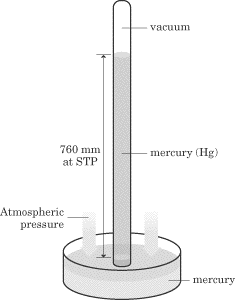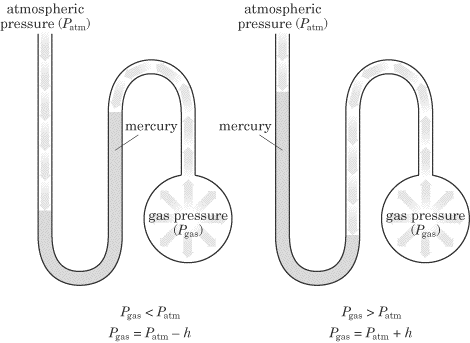- All gas particles are in constant, random motion.
- All collisions between gas particles are perfectly elastic (meaning that the kinetic energy of the system is conserved).
- The volume of the gas molecules in a gas is negligible.
- Gases have no intermolecular attractive or repulsive forces.
- The average kinetic energy of the gas is directly proportional to its Kelvin temperature and is the same for all gases at a specified temperature.
Only four measurable properties are used to describe a gas: its quantity,
temperature, volume, and pressure. The quantity (amount) of the gas is usually
expressed in moles (n). The temperature, T, of gases
must always be converted to the Kelvin temperature scale (the absolute
temperature scale). The volume, V, of a gas is usually given in
liters. Finally, the pressure, P, of a gas is usually expressed in
atmospheres. Gases are often discussed in terms of standard temperature and
pressure (STP), which means 273K (or 0ºC) and 1 atm.
Example
Which of the following statements is not true of ideal gases?
- The volume occupied by gas particles is only significant at very low pressures.
- Gas molecules occupy an insignificant volume compared to the volume of the container that holds them.
- The particles of a gas move in random straight line paths until a collision occurs.
- The collisions that occur between gas particles are considered elastic.
- At a given temperature, all gas molecules within a sample possess the same average kinetic energy.
Explanation
In this example, choice 1 is incorrect. Choices 2, 3, 4, and 5 all describe an
ideal gas. Choice 1 makes an incorrect assumption: it begins with a true
statement about volume not being very significant but then turns around and
gives the incorrect scenario—if the pressure is low, then gas particles undergo
very few collisions, so the volume is insignificant. The volume only becomes
significant if gas particles collide often, increasing the chances that
intermolecular forces will hold them together.
Measuring the Pressure of a Gas
Gas pressure is a gauge of the number and force of collisions between gas
particles and the walls of the container that holds them. The SI unit for
pressure is the pascal (Pa), but other pressure terms include
atmospheres (atms), millimeters of mercury (mmHg), and torr.
The following is a list of all of the standard pressure in every unit for
pressure. Memorize these for the exam so you can convert units where necessary:
760 mmHg
760 torr
1.00 atm
101,325 Pa
101.325 kPa
The piece of lab equipment specifically designed to measure the pressure of gases
is known as the barometer. A barometer uses the height of a column of
mercury to measure gas pressure in millimeters of mercury or torr (1 mmHg = 1
torr). The mercury is pushed up the tube from the dish until the pressure at the
bottom of the tube (due to the mass of the mercury) is balanced by the
atmospheric pressure.

When using a barometer, you calculate gas pressure with the following equation:
Gas pressure = atmospheric pressure - h (height of the mercury)
The open-tube manometer is another device that can be used to measure
pressure. The open-tube manometer is used to measure the pressure of a gas in a
container.

The pressure of the gas is given by h (the difference in mercury levels)
in units of torr or mmHg. Atmospheric pressure pushes on the mercury from one
direction, and the gas in the container pushes from the other direction. In a
manometer, since the gas in the bulb is pushing more than the atmospheric
pressure, you add the atmospheric pressure to the height difference:
gas pressure = atmospheric pressure + h
There is one other possibility for a manometer question that could appear on the
SAT II Chemistry test: they could ask you about a closed-tube manometer.
Closed-tube manometers look similar to regular manometers except that the end
that’s open to the atmospheric pressure in a regular manometer is sealed and
contains a vacuum. In these systems, the difference in mercury levels (in mmHg)
is equal to the pressure in torr.
Next to display next topic in the chapter.
Practice Questions
Test Prep Lessons With Video Lessons and Explained MCQ
Large number of solved practice MCQ with explanations. Video Lessons and 10 Fully explained Grand/Full Tests.